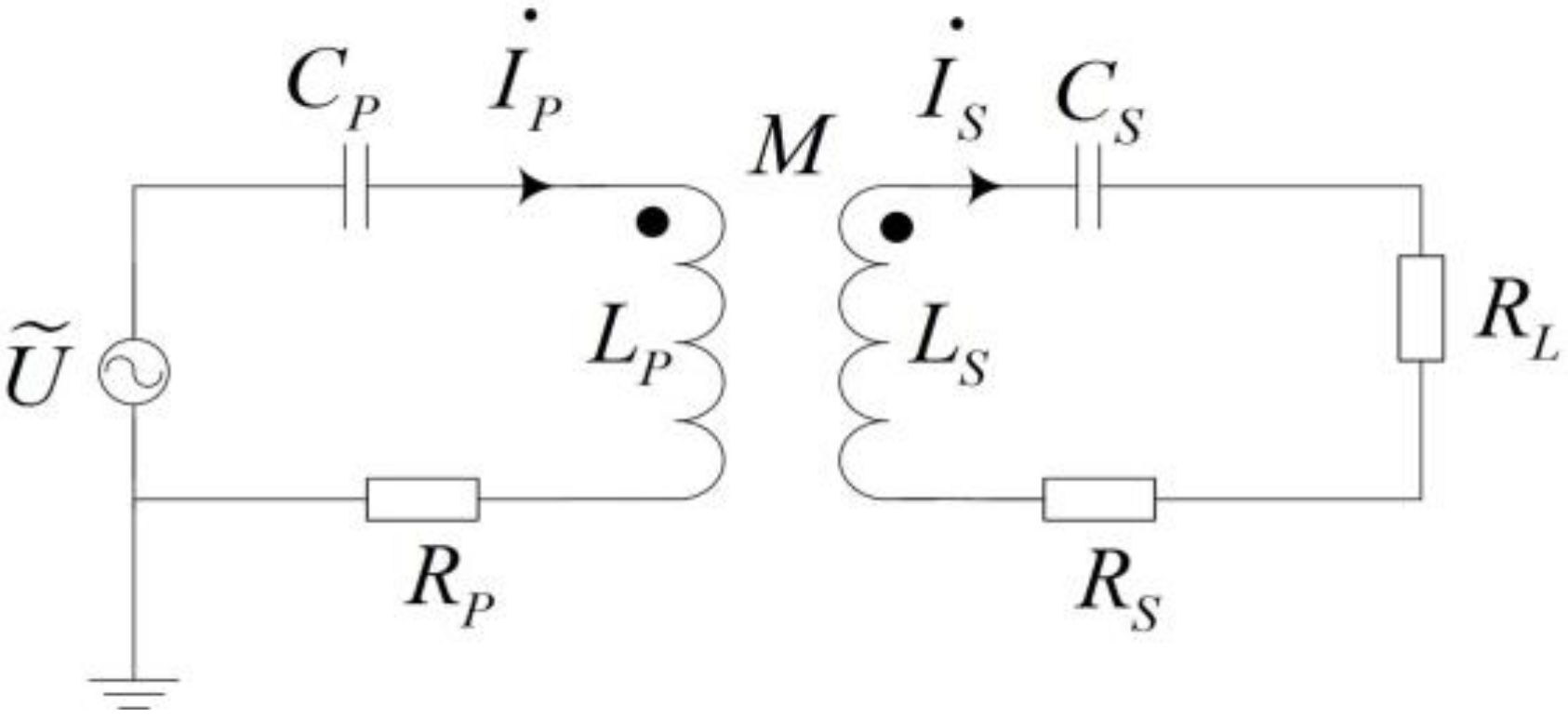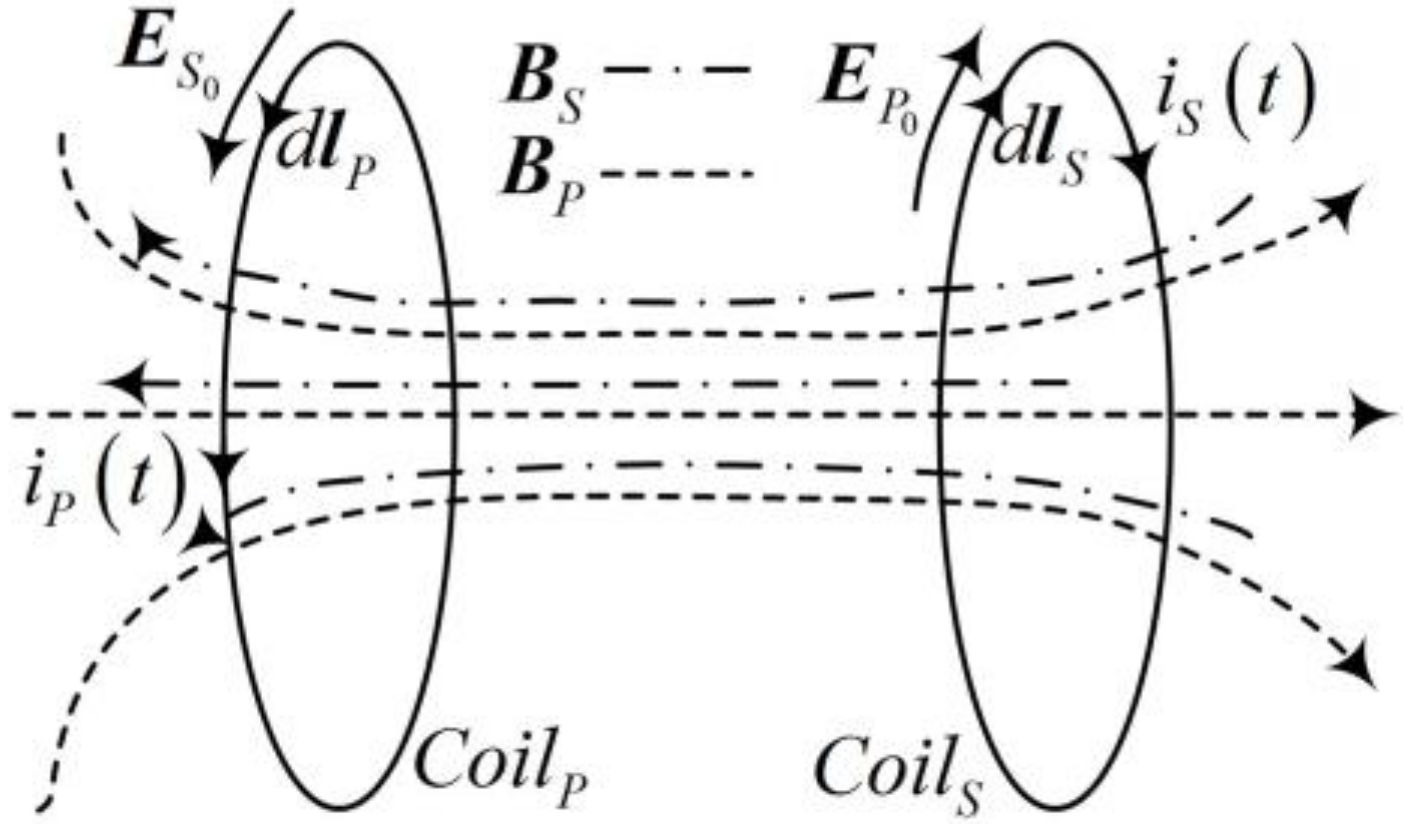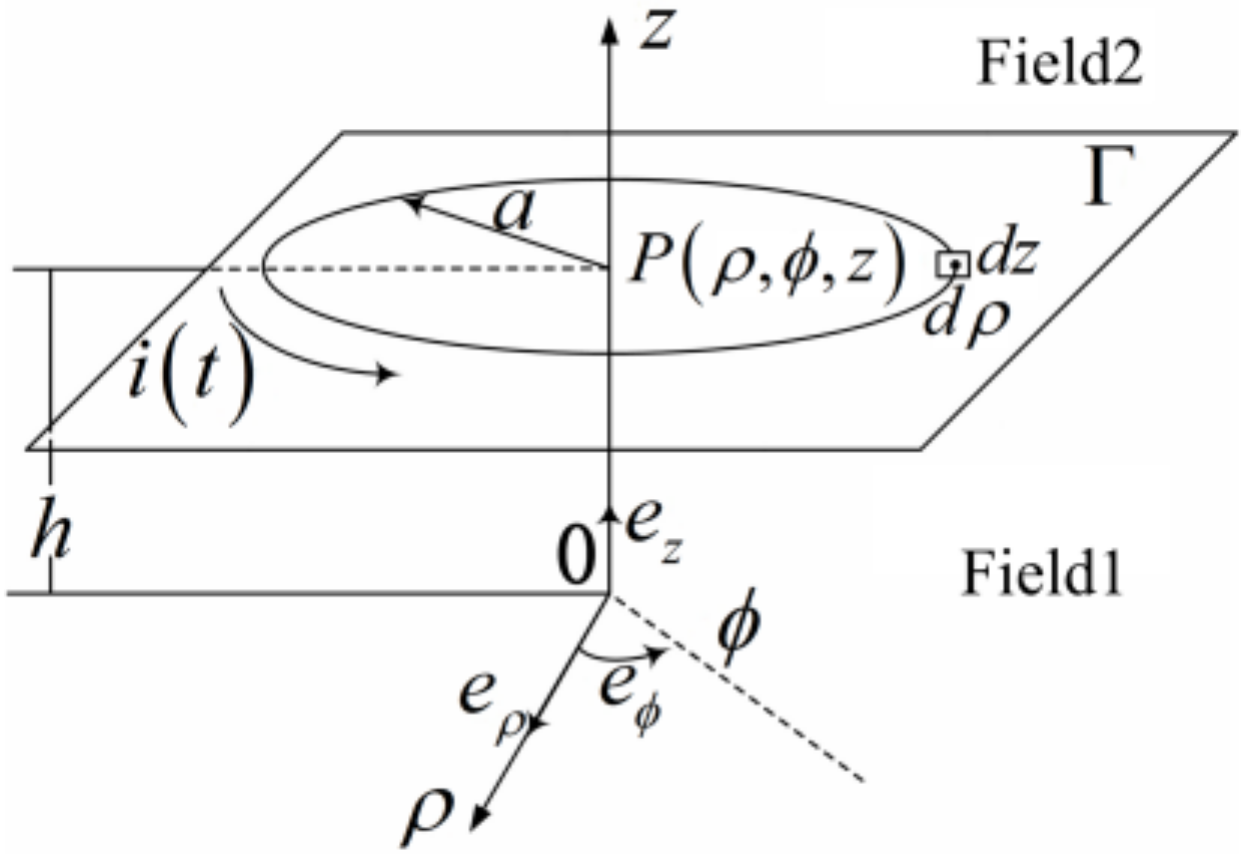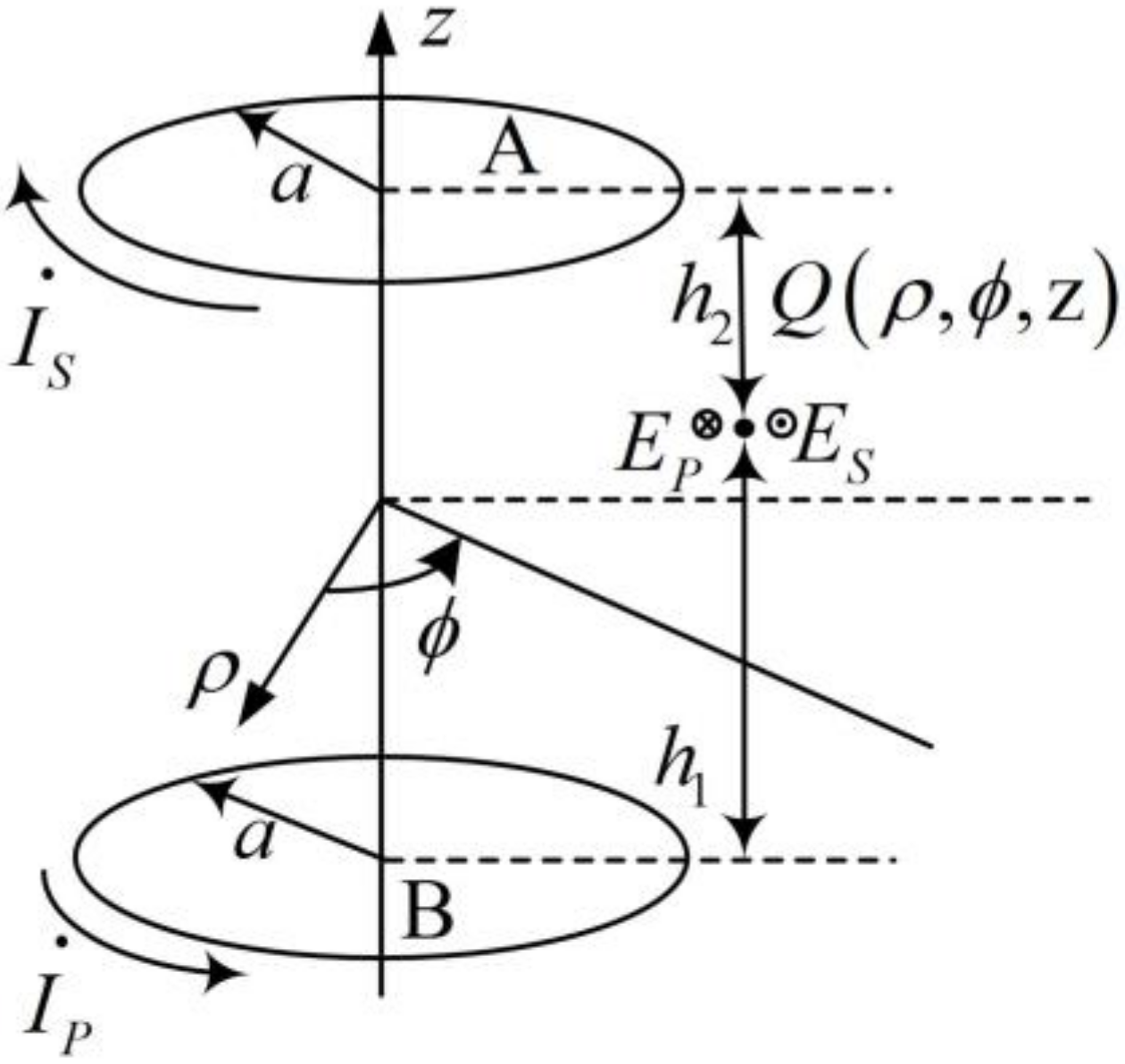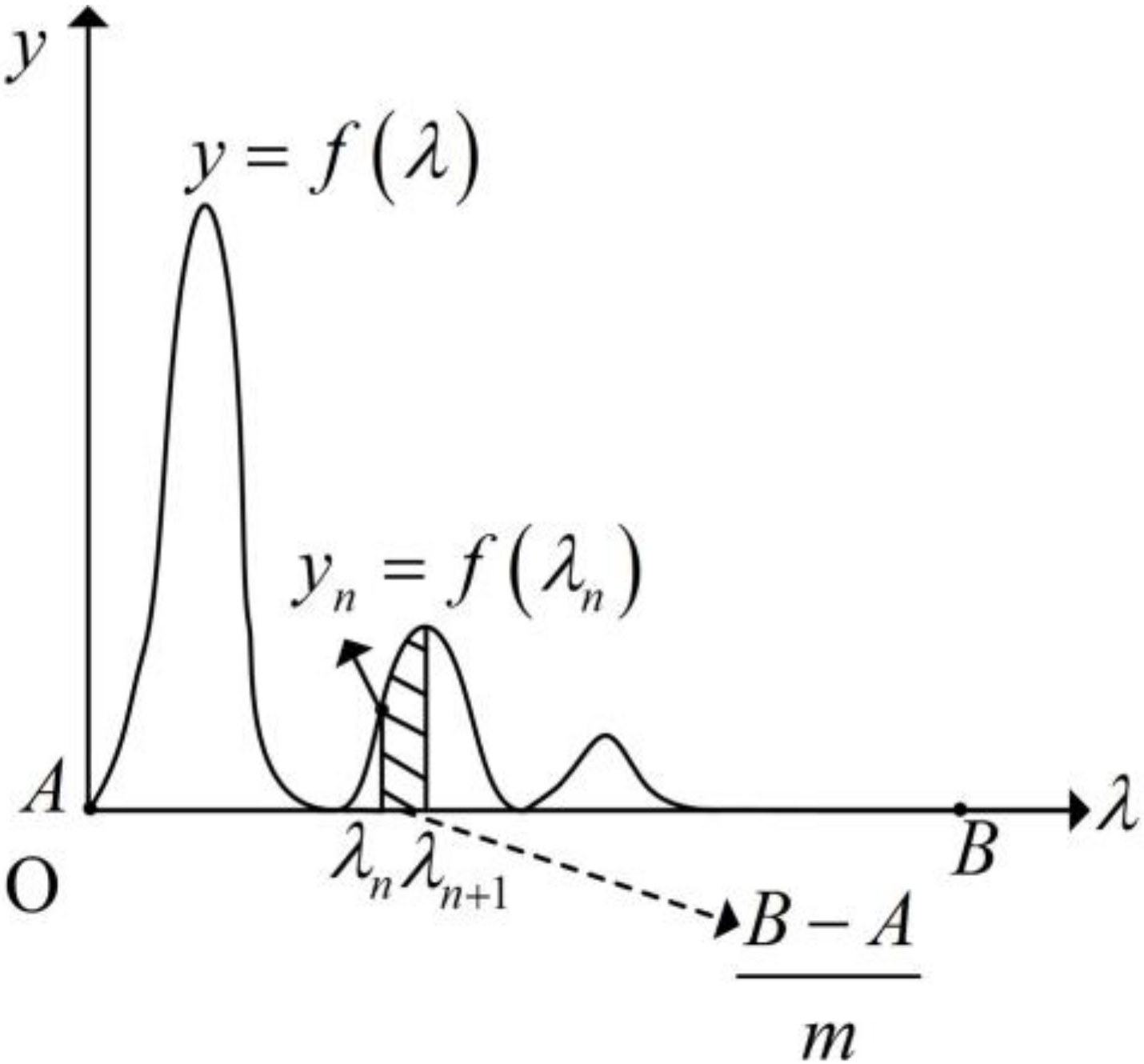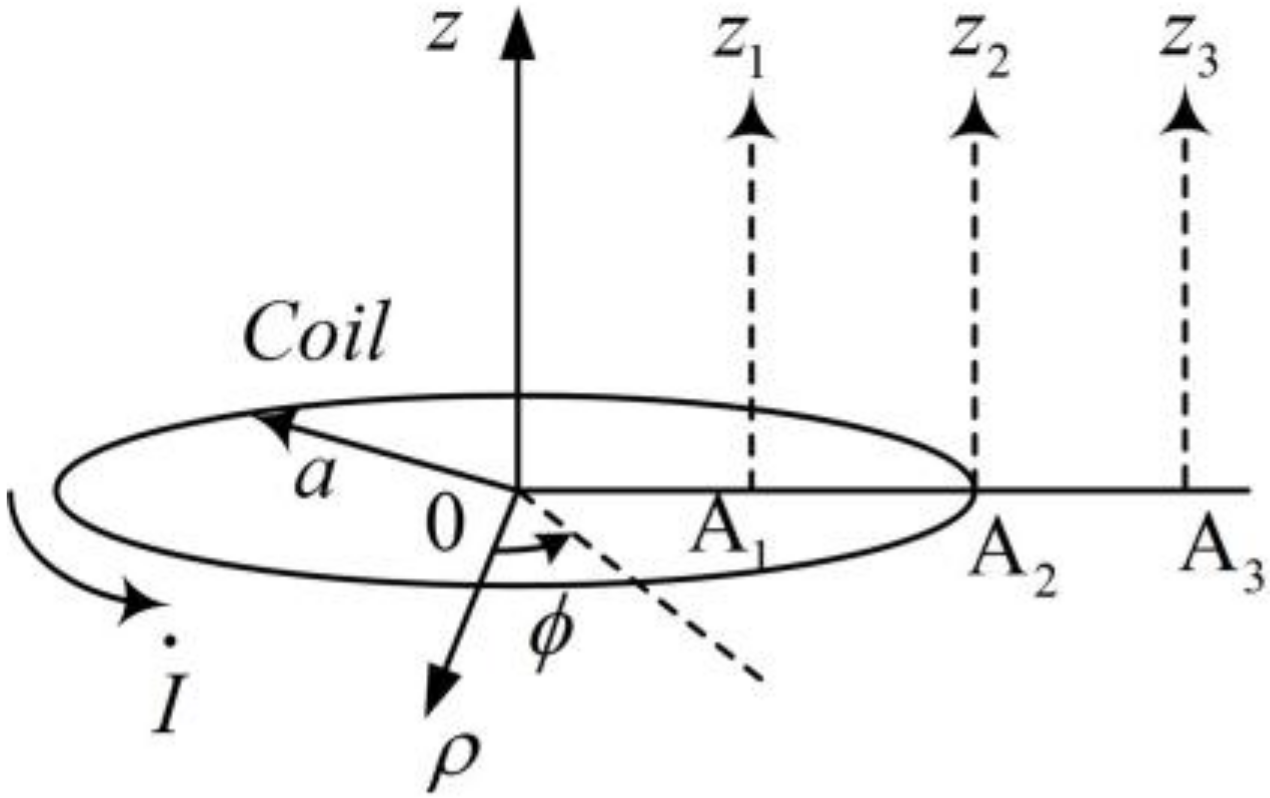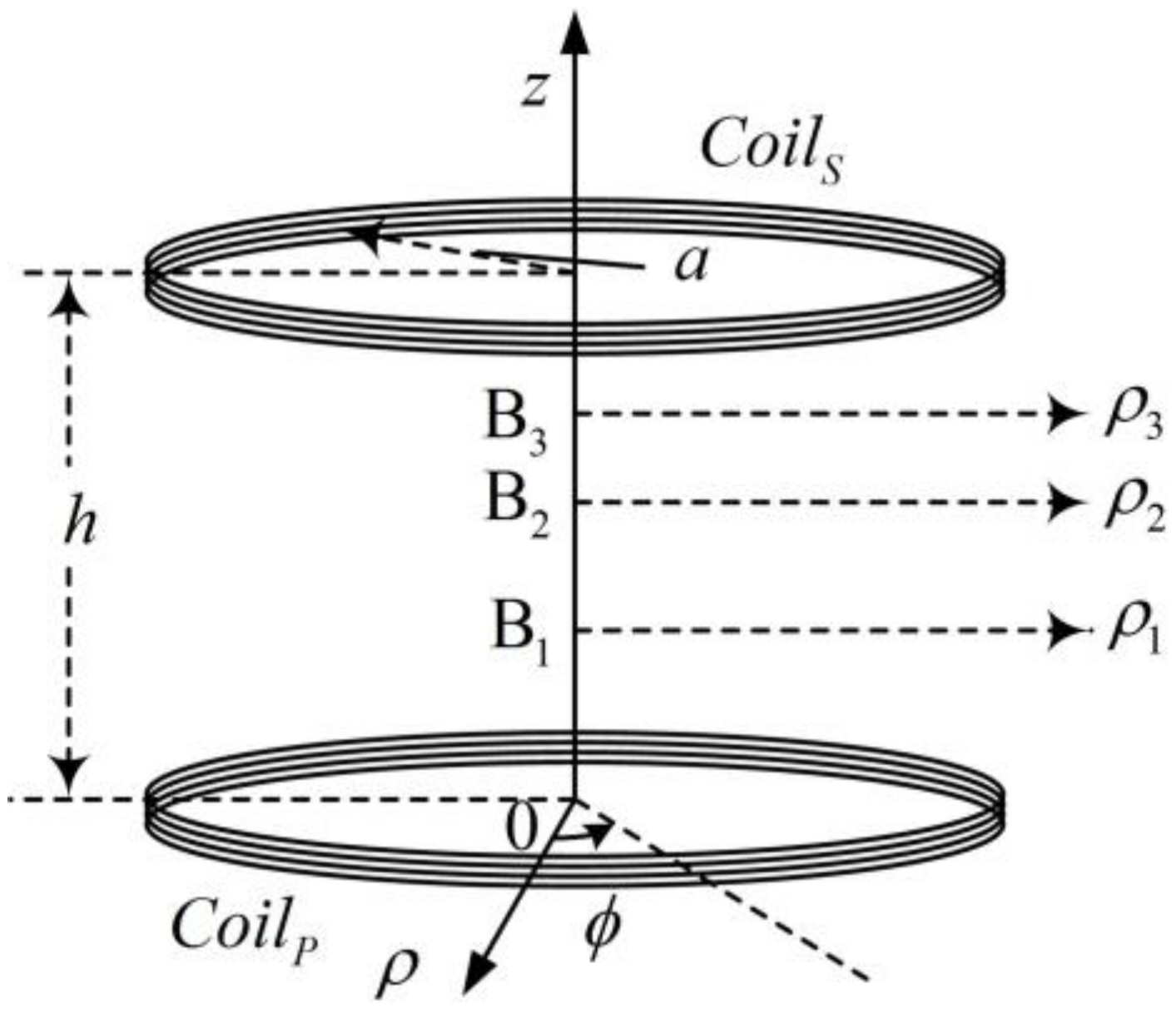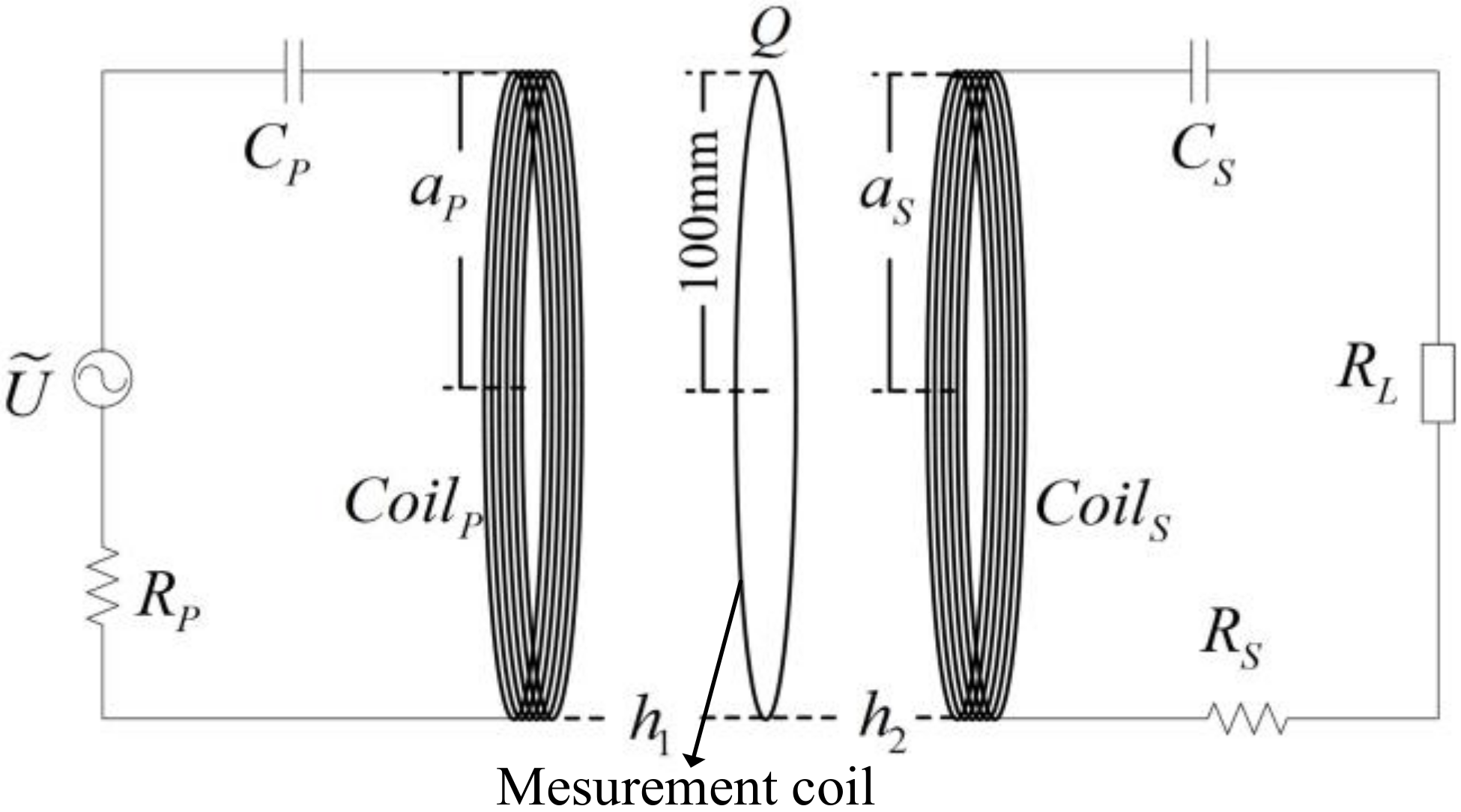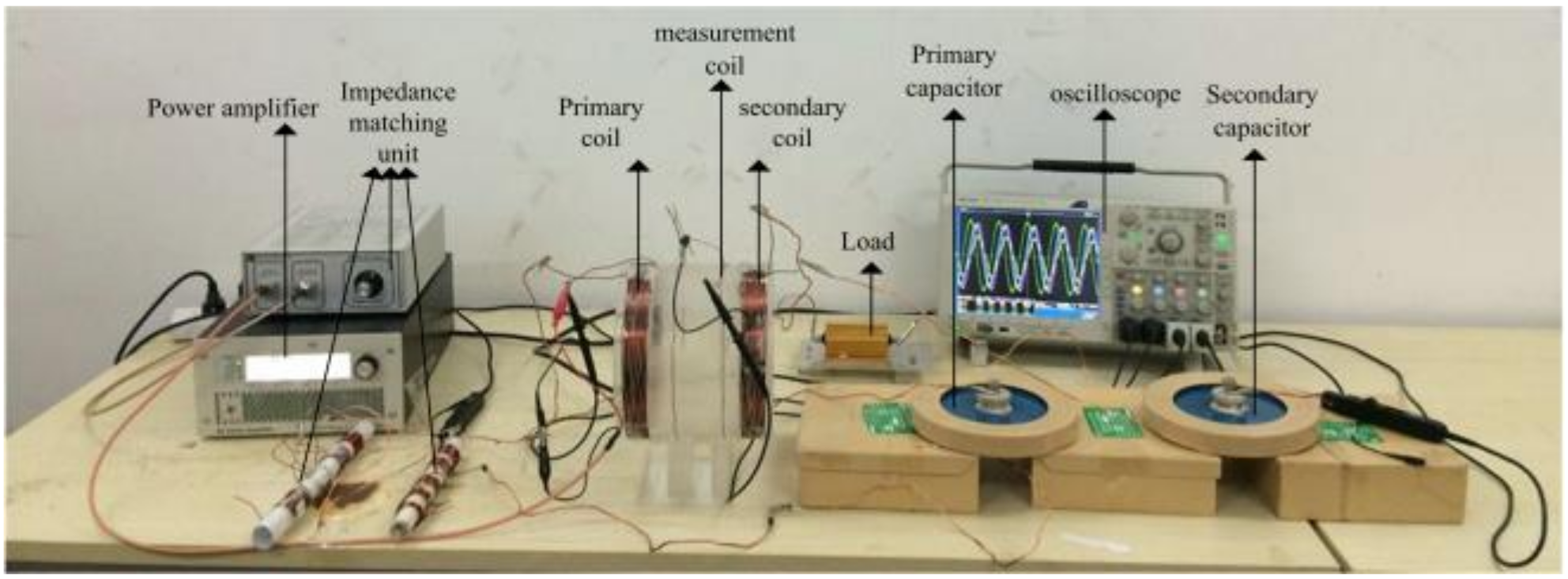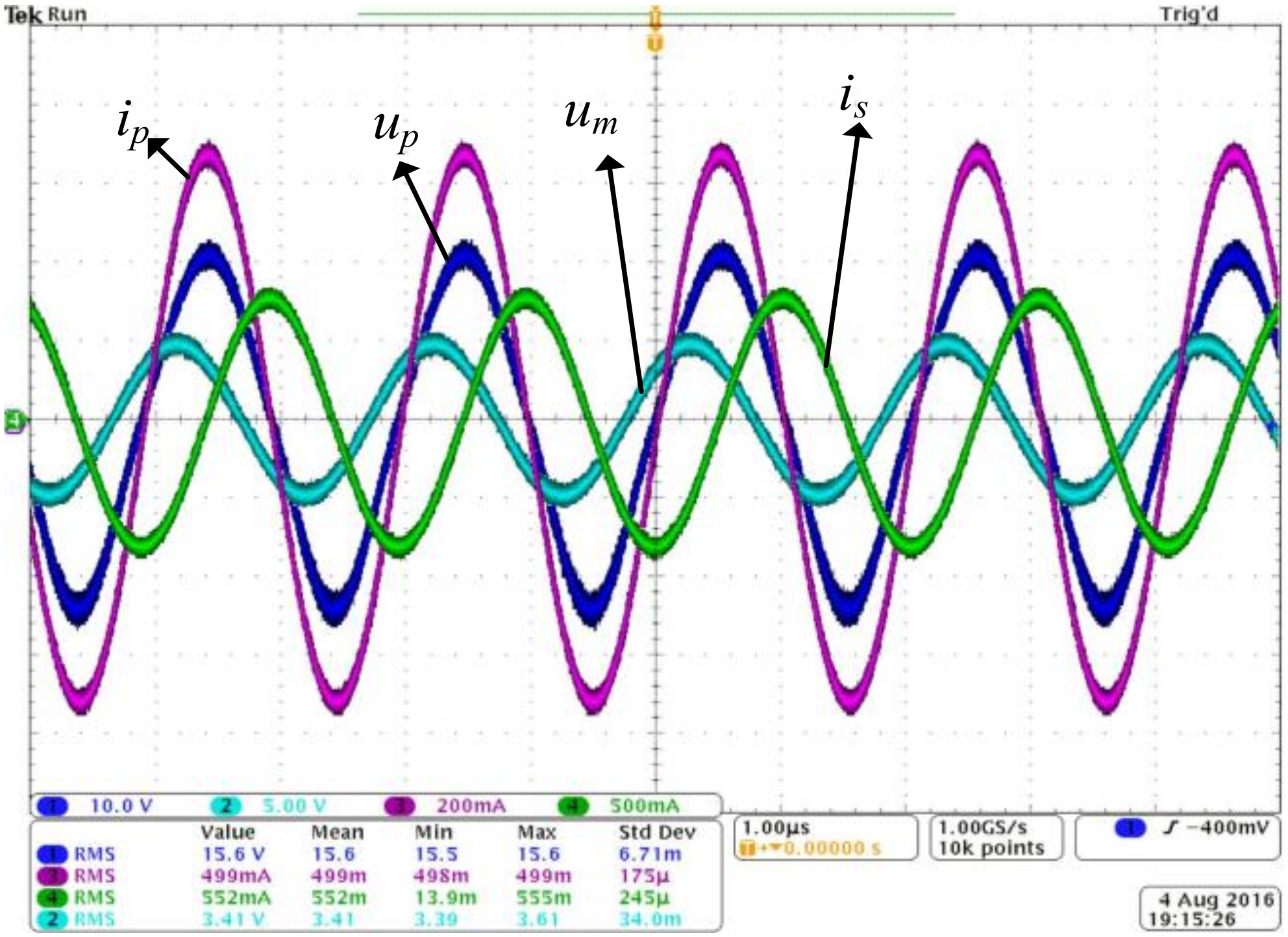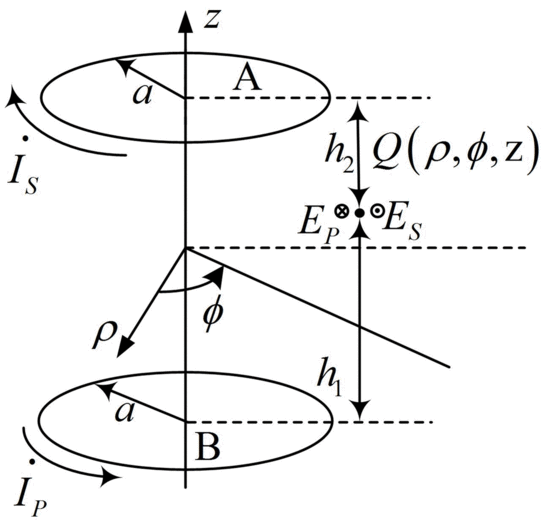1. Introduction
Inductive power transfer (IPT) technology is a new type of energy transfer method by which energy is transferred from source to load wirelessly, according to the electromagnetic induction theory. In recent years, IPT has developed rapidly and been used for electric vehicles [
1,
2], biomedical implantable devices [
3,
4] and wireless charging in intelligent mobile phones [
5]. An adaptive four-coil structure was used to improve the power transfer efficiency of the whole system [
3]. A square coil was utilized to maximize the power received by the load and the resonant frequency was adjusted to maximize the coil’s quality factor [
4]. A mobile phone shell and the coil in the secondary side were used as the resonance bodies, which proposed a novel way to provide electrical energy for a mobile phone [
5].
There are many applications for IPT systems, but the power transfer mechanism in between the coupled coils in an IPT system is indistinct. Therefore, research on the mechanism of energy transfer of the coil coupler is very important for IPT technology. Currently, research methods for IPT systems can mainly be classified into two categories: The coupled-mode theory and the equivalent circuit method. These have been proven to be equivalent through analysis with a 4-coil IPT system [
6]. In 2007, the team led by Soljačić in MIT (Massachusetts Institute of Technology) elaborated on the analysis and modelling method of the system from the perspective of the coupled-mode theory, which laid a theoretical foundation for the further development and popularization of IPT technology [
7]. Coupled-mode theory is used to study the coupling principle of power transmission. The power transfer process from one resonant body to another can be expressed as a first-order partial differential equation according to it. This equation provides an accurate and effective modelling method for IPT systems, as well as an analytical tool to understand the power transfer mechanism in strongly coupled systems. In IPT systems, when the two resonant coils are close, strong coupling exists between them. Under these conditions, with the help of coupled-mode theory, it was found that the energy loss in the primary coil was much slower than the power transferred from the primary coil to the secondary coil [
8], thus, the energy transmission was quite efficient. From the perspective of circuit theory and practical applications, the mutual inductance model was used to obtain the relationship between system transfer efficiency and parameters. The mutual inductance model can also be utilized to analyze the power transfer capability as well [
9,
10].
Although the mutual inductance model is mature, its accuracy depends on the accurate acquisition of the coil parameters. In high-frequency cases, the coil impedance characteristic varies greatly with the operating frequency. Coupled-mode theory has been widely adopted in recent years, but in the analysis process, the state quantities are employed instead of electrical parameters. In addition, the coupled-mode theory model is relatively abstract, and it is difficult to build the mathematical model with lumped circuit parameters. By using the Biot–Savart law, the analytical solution of the electromagnetic field in the IPT system was calculated through the magnetic vector potential. However, the derivation process of the analytical solution of the electric field and magnetic field in IPT systems and the experimental verification were not introduced [
11].
In [
12], the derivation of the magnetic field, based on the analysis of a current-carrying conductor, is accurately calculated and a good approximation has been done when the far-field is calculated. The mutual inductance and self-inductance of two coaxial coils in a multilayer media have been introduced, and the frequency limitations of magnetic substrates are also established [
13]. The far-field solution of a loop of any size is deduced in [
14], and the far-field of a square loop is also discussed, finally proving that when the circular and square loops are the same in area and small in size with respect to wavelength, their far-field solutions are identical, but they are different when the size is large in terms of wavelength. From [
15], it can be seen that the far-field approximation solution of the electromagnetic field cannot be used in near-field systems because of the large relative percent error. The exact integration of vector potentials of thin circular loop antennas is then introduced to solve this problem.
In this paper, using Maxwell’s equations, the analytical solution for the synthesized electric and magnetic field, both by the primary and secondary circular coil in an IPT system, are deduced in this paper, and the electric field is analyzed in detail. The numerical integration method is used to find the induced voltage in the secondary coil. Finite element software is utilized to compare with the analytical results, and an IPT system is set up to validate the analytical results experimentally.
2. Mutual-Inductance Model of the IPT System
The system structure is given in
Figure 1. The alternating current from the source is first converted into a direct current through an AC/DC converter and then into a high-frequency alternating current through another AC/DC converter. Simultaneously, the transmitting coil
CoilP converts the electrical energy into electromagnetic energy, and the receiving coil
CoilS absorbs the energy from the near-zone electromagnetic field, converting it into electrical energy. The electrical energy is then conveyed through a rectifier to charge the battery. The coupling between the primary and secondary systems is defined as mutual inductance
M.
The mutual inductance model is shown in
Figure 2. The equivalent series impedances on
CoilP and
CoilS are
RP and
RS, respectively. The load impedance is
RL. In this paper, the series-series compensation network is used in the IPT system, and compensating capacitors in the primary and secondary side are
CP and
CS, respectively. The primary side is powered by a voltage source
U and the primary circuit current and the secondary circuit current are
IP and
IS, respectively. According to the KVL equation, the following equations can be obtained:
When the primary and secondary circuits are resonant,
. The system efficiency and load power are derived as follows [
16]:
Figure 3 shows a schematic of the electromagnetic field around the primary and secondary coil. The sine alternating current in the primary side coil generates the time-harmonic electromagnetic field. We assume that the time-harmonic electric field induced at the position of
CoilS is
. Then, the integral of
on the secondary loop is equal to the induced voltage
US. Combined with
Figure 2 and
Figure 3, the following expression is obtained:
where
dlS is a directional micro-element on the secondary side coil. In this paper, the bold symbols represent space vectors.
Similarly, the corresponding time-harmonic electric field
will be generated around
CoilP by the induced current in the secondary coil. The corresponding induced voltage is
. Therefore, the working principles of an IPT system can be understood from the perspective of an electromagnetic field. In
Section 3, Maxwell’s equations are used to calculate the electric fields generated by the primary and secondary coil in detail, and the derivation process is easy to understand for researchers engaged in IPT.
4. Electric and Magnetic Field in the IPT System
In this section, the analytical solutions for the electric and magnetic field, induced both by the primary and secondary coil, are deduced, and the numerical integration method is used to acquire numerical results.
4.1. Analytical Solution of the Electric and Magnetic Field
As shown in Equation (7), there is a one-to-one correspondence between the electric field E and the magnetic flux density B. When the analytical solution of E is obtained, the analytical solution of B can also be uniquely determined. Thus, in this section, the electric field is calculated only.
An electric field illustration of the sampling point in the double-coil system is given in
Figure 5. The radius of each coil is
a. The current in the primary and secondary coil is defined as
IP and
IS, respectively.
NP and
NS are the numbers of turns in the two coils, respectively. The distances from
CoilP and
CoilS to the point Q are denoted as
h2 and
h1, respectively.
The electric field only exists along the
ϕ direction. Thus, by combining Equations (2) and (5), when the system is operated at its resonant frequency, the following equation can be obtained:
where
is the electric field at
CoilS produced by the current in
CoilP:
The total electric field at point Q is
E = EP + ES, and
where
EP and
ES are the electric fields produced by the current in the primary and secondary coils, respectively. Equations (46) and (47) laid the base for the next step numerical calculations to find the distribution of the E and H field.
4.2. Numerical Integration Method for the Analytical Solution
The integral of the function in Equation (46) needs to be calculated and the integration interval is from A to B.
Since it is difficult to determine the primitive function of the integrand f(λ), the integration method is used to acquire an approximation result. In the numerical integration method, the integration interval is divided into parts, and the sum of their areas is the approximation of the integral of the function f(λ) from A to B.
As shown in
Figure 6, by defining the area of each small part as Δ
s = f(
λn)·(
B − A)
/m,
If
m tends to infinity, then
In Equation (46), A is equal to zero. When a = ρ = 0.1 and λ = 1000, f(λ) tends to zero, so the upper limit of the integral, (i.e., B) can be set to be 1000. To ensure accuracy, the number of tiny intervals was defined as m = 1 × 105.
The final solutions are obtained by combined analytical derivation and numerical calculations. In the next section, the analytical solution is verified by simulation.
6. Experimental Verification
The electric field intensity cannot be measured directly. According to Equation (42), the electric field generated by the coil is along the
ϕ direction, but the electric field intensity is independent of
ϕ. For a single-turn measurement coil, when its plane is oriented parallel to the plane of the current-carrying coil, the electric field intensity can be measured using the relationship
U = ∮
l|
E|
dl. When current flows in the source coil and the measurement coil is opened, the relationship between the open-circuit voltage and the circular electric-field strength at the measurement coil can be expressed as |
E|
= U/(
2πa), in which
a is the radius of the measurement coil. The experimental configuration is shown in
Figure 11.
By changing the position and size of the measurement coil, the variation of the electric-field strength at different positions can be measured, where Q is an arbitrary point on the measurement coil. To facilitate the experiment, the radius of the measurement coil was set equal to the radius of the primary and secondary coils.
When the secondary side is at resonant state, the reflected impedance from the secondary side to the primary side is purely resistive, while the resonant frequency of the primary side is independent of the secondary side. The experimental steps were as follows [
18]:
Firstly, a compensation capacitor with
CS = 1000 pF, a load with
RL = 20 Ω and an adjustable current source were connected in series with the primary coil. The current source frequency was adjusted to a specific value so that the load current and voltage were in the same phase, which is the resonant frequency. In the experiment, the measured resonant frequency was set at
f0 = 486.7 kHz. Then, the current source was removed and the secondary side of the circuit was connected as shown in
Figure 11.
Secondly, to achieve full resonance (i.e., the primary side and secondary side are both resonant), a compensation capacitor must be connected in series with the primary coil. The experimental circuit configuration is shown in
Figure 11. The experimental set up is shown in
Figure 12, and the frequency of the power amplifier shown in
Figure 12 was maintained at
f0 = 486.7 kHz, and the compensation capacitance
CP was adjusted until the voltage and current of the power source were in the same phase, at which point the circuit achieves full resonance.
The relevant parameters are listed in
Table 1.
Finally, different values of
h1 in
Figure 11 were chosen, and the output current of the power amplifier was changed. The corresponding induced voltages of the measurement coil at different positions were measured. The voltage was divided by the perimeter of the measurement coil to obtain the electric field intensity at that point.
Figure 13 shows waveforms of the experiment result, measured by Tektromix DPO4104B when the effective current on the primary side was 0.499 A and
h1 = 52 mm. The purple line is the primary side current
ip, the dark blue line is the output voltage of the power amplifier
up, the green line is the induced current in the secondary side coil
is and the light blue line is the induced voltage of the measurement coil
um.
The experimental results of electric field intensity at different h values are shown in
Figure 14. H
1, H
2 and H
3 represent values of
h1 at 27 mm, 52 mm and 80 mm, respectively. The largest relative error, which is below 6%, happens under the experimental condition that
h1 = 80 mm, and the maximal relative error is below 2% at the other two positions. The reason why the analytical solution is always larger than the experiment data is that during the numerical integration, the coil resistance is not considered. It can be found that near the primary side, the analytical solution is just a little higher than the experiment data, the reason for this is that near the primary side the electric field intensity is determined dominatingly by the current in primary side. It is reasonable to believe that the experiment has validated the analytical solution.
7. Conclusions
To reveal the energy transfer mechanism in the IPT system, it is important to study the distribution of the time-harmonic electric and magnetic fields in the IPT system. In this paper, the analytical solution of the time-harmonic electric and magnetic fields in an IPT system was deduced in detail, and the numerical integration method was used to find the distribution of the E and H fields on the basis of the analytical solution.
Firstly, based on the Maxwell’s equations, the Laplacian of the electric field and the magnetic field strength around the current-carrying coil were derived theoretically. The analytical expression of the electric field was calculated in an integral form, and the result can be obtained by the simple trapezoidal integration method. The final solutions were obtained by combined analytical derivation and numerical calculations.
Secondly, the correctness of the analytical results for the electromagnetic field in the IPT system was verified utilizing the finite element software COMSOL.
Finally, an IPT system was set up, and the electric-field strength between the primary and secondary coils was measured. The experimental results further verify the correctness of the analytical solution. The analytical solution developed in this paper can be applied to analyze electric and magnetic fields in any uniform medium.

